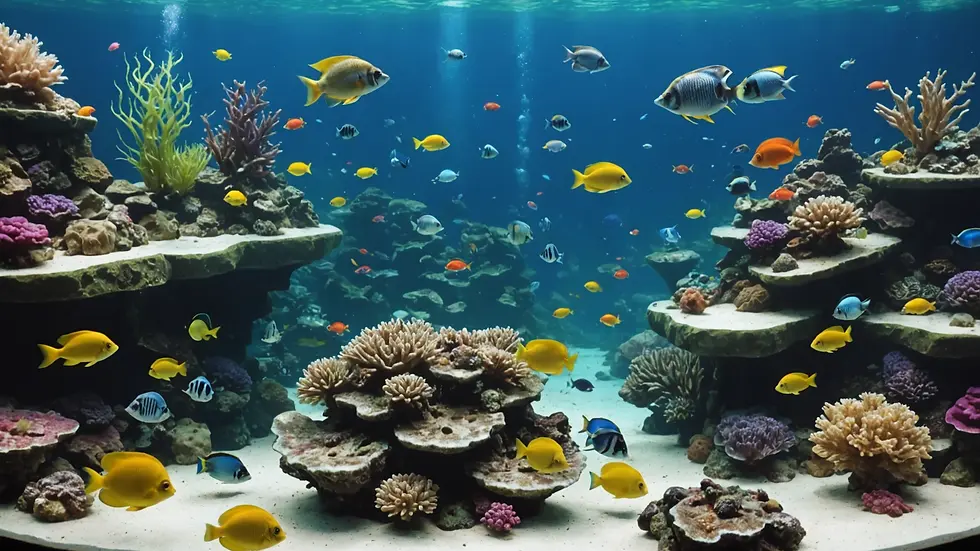How Do Different Species Get Along? A Guide to Species Compatibility
- Jyotiraj Borah
- Feb 10
- 4 min read
Are you curious about how different species can live together peacefully? Understanding species compatibility is vital for anyone looking to maintain a healthy ecosystem, whether at home or in the great outdoors. In this guide, we will explore the essentials of species compatibility, enabling you to foster beneficial relationships among various species in your aquarium, garden, or any living space.
The Significance of Species Compatibility
Species compatibility is key to creating a thriving environment. When species coexist harmoniously, they benefit from each other, leading to a balanced ecosystem. For example, studies have shown that diverse fish communities in an aquarium can reduce stress levels, improving their overall health by up to 30%. Conversely, when incompatible species are paired together, they can disrupt this balance, leading to stress, aggression, or even extinction in severe cases.
Understanding which species can thrive together empowers you to create spaces where all creatures can live healthily. This knowledge is especially important in environments like aquariums, terrariums, and gardens, where a variety of species are commonly managed.
Key Factors Affecting Compatibility
Several essential factors influence the compatibility of different species. By recognizing these elements, you can make informed decisions about which species to house together.
1. Habitat Requirements
Every species has specific habitat needs, including temperature, pH levels, light, and available space. For instance, tropical fish such as neon tetras require water temperatures of around 75-80°F, while goldfish thrive in cooler waters at approximately 65-70°F. Providing environments with similar requirements is critical for the well-being of all species involved.
2. Dietary Needs
Diet greatly impacts compatibility. Some species eat only plants, while others might eat only other animals. For instance, if you house herbivorous fish alongside carnivores, the latter may dominate food resources, leading to starvation and aggression. Ensuring that all species have enough food that meets their dietary needs without competition is essential.
3. Behavioral Traits
Behavioral compatibility is crucial for peaceful coexistence. Some species can be territorial and aggressive, like bettas, while others, such as guppies, are typically more laid-back. Mixing aggressive and timid fish can create a stressful environment. For example, a study found that adding too many aggressive fish can increase stress levels in timid species by over 50%. Familiarizing yourself with these behavioral traits helps in creating a harmonious habitat.
4. Reproductive Habits
The reproductive behaviors of some species can complicate compatibility as well. Certain species, like mollies, breed quickly and can become very territorial during mating season, potentially stressing out other species. Conversely, quieter species may be overwhelmed by aggressive mating behaviors. Understanding these factors can help you arrange species that do not disrupt each other's reproductive cycles.
Compatibility in Aquatic Environments
Aquariums vividly illustrate species compatibility, showcasing many fish and aquatic creatures.
1. Freshwater Fish Compatibility
Freshwater fish species vary widely in compatibility.
Community Tanks: Species like neon tetras, guppies, and corydoras are often recommended for community tanks since they thrive in similar water conditions and exhibit peaceful behavior.
Aggressive Species: In contrast, cichlids are known for their aggressive tendencies. It's vital to choose tank mates that can defend themselves, such as larger or more robust fish.

2. Saltwater Fish Compatibility
Saltwater aquariums can be even more challenging regarding species compatibility.
Compatible Species: Clownfish, known for their symbiotic relationship with anemones, generally coexist well with gobies and some other peaceful species. However, some tangs can be aggressive, so introducing species that can hold their ground is essential.
Anemones and Corals: Researching reef-safe species is crucial if you plan to keep anemones or corals, as some fish can harm these delicate organisms.
Compatibility in Terrestrial Environments
Species compatibility in terrestrial environments is equally important for creating thriving ecosystems.
1. Plants and Animals
Compatibility among plants and animals stems from their ecological roles.
Companion Planting: In gardens, pairing plants like marigolds with tomatoes can ward off pests, increasing vegetable production by up to 30%.
Pets and Plants: If pets are involved, it is essential to choose non-toxic plants. For instance, many cat owners opt for cat grass to ensure their feline friends can chew safely without harm.
2. Garden Ecosystems
Understanding species' roles enhances the balance in a garden ecosystem.
Pollinators: Attracting bees can significantly boost flowering plants' yields, improving the productivity of your garden. It is estimated that a single bee colony can pollinate up to 2 million flowers daily.
Natural Predators: Introducing beneficial insects like ladybugs can effectively control pest populations, reducing the reliance on harmful pesticides by nearly 50%.
Additional Considerations for Compatibility
1. Environmental Needs
Being aware of your chosen species' environmental needs can significantly enhance compatibility. Consider factors such as humidity levels, soil types, and sunlight exposure when deciding which species to introduce together.
2. Social Structures
Species have varying social structures. Many animals, such as dogs or horses, tend to live in social groups, while reptiles like many lizards prefer solitude. When housing multiple species together, it is essential to consider these social needs for a harmonious living situation.
Creating a Harmonious Ecosystem
Species compatibility is fundamental for maintaining healthy ecosystems at home, whether in an aquarium or garden. By understanding the factors that influence compatibility—like habitat requirements, dietary needs, behavioral traits, and reproductive habits—you can create nurturing environments where different species thrive.
Taking the time to research your species can foster peaceful coexistence, allowing them to positively contribute to their ecosystem. With thoughtful planning and consideration, you can design spaces that not only support individual species but also enhance the biodiversity and beauty of your surroundings.

Selecting species that complement one another will enrich your experience in your ecosystem. Happy gardening or aquascaping, and may your species thrive in harmony!




Comentarios